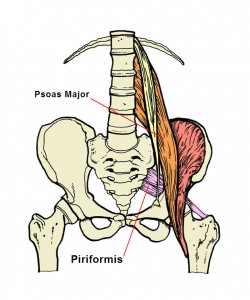 The psoas and piriformis muscles are two muscles that connect the legs to the spine (gluteus maximus is the third). Together—psoas from the front and piriformis in back– they work to keep the spine afloat above the pelvis. The psoas pulls down from the front and the piriformis pulls in the same direction from behind.
The psoas and piriformis muscles are two muscles that connect the legs to the spine (gluteus maximus is the third). Together—psoas from the front and piriformis in back– they work to keep the spine afloat above the pelvis. The psoas pulls down from the front and the piriformis pulls in the same direction from behind.
When it comes to back pain and dysfunction you can’t have trouble in one of these muscles without it affecting the other. When it comes to good posture and spot-on movement patterns the psoas and piriformis muscles are meant to lead the way towards grace and stability.
One way to see this is that the spine is strapped onto the legs at the front and the back by the psoas major and piriformis. If they are both long and toned the spine can sit directly on top of the pelvis. If the psoas major is tight it will pull the lumbar spine forward which will pull the upper spine backwards. Once this happens there is no way for the piriformis to live in its proper place. If the piriformis is tight it pulls the feet wider than parallel and also turns the inner thighs towards the front plane of the body. Once the inner thighs have moved even slightly forward the psoas major loses the tension across the rim of the pelvis that it needs for optimal functioning.
The forward and downward pull of the psoas on the lumbar spine is counteracted by the downward pull of the piriformis on the sacrum. If the pelvis is aligned correctly it is possible for this to happen and these two muscles will help to hold the spine aloft with minimal excess force. Unfortunately I meet few people with a well aligned pelvis and as a result the imbalance of the psoas and piriformis muscles affects all parts of their lives.
The failure of the psoas and piriformis in pulling off their balancing act manifest across the full spectrum of our activities—sitting, standing, walking, running and even sleeping will be influenced by the relationship of the two important muscles.
***
